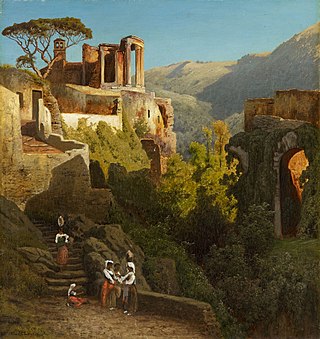
Rudolf Swoboda (1859–1914) was a 19th-century Austrian Orientalist painter. He was sometimes known as The Younger, to distinguish him from his uncle Rudolf, who was also an artist.

Rudolf Eitelberger was an Austrian art historian and the first Ordinarius for art history at the University of Vienna. He is considered as the founder of the Vienna School of Art History.

Rudolf Koller was a Swiss painter. He is associated with a realist and classicist style, and also with the essentially romantic Düsseldorf school of painting. Koller's style is similar to that of the realist painters Gustave Courbet and Jean-Baptiste-Camille Corot. Considered Switzerland's finest animal painter, Koller is rated alongside George Stubbs, Rosa Bonheur and Théodore Géricault. While his reputation was based on his paintings of animals, he was a sensitive and innovative artist whose well-composed works in the "plein air" tradition, including Swiss mountain landscapes, are just as finely executed.

Hugo Charlemont was an Austrian painter. Born in Jemnice, Moriva he was the son of Matthais Adolf Charlemont. He studied art at the Academy of Fine Arts. He died in Vienna.

Leopold Carl Müller was an Austrian genre painter noted for his Orientalist works.

Franz Rumpler was an Austrian genre and landscape painter.

Friedrich Kriehuber was an Austrian draftsman, lithographer and woodcut artist.
Swoboda is a surname of Czech origin. A variant of Svoboda, it is popular mainly among West Slavic nations. In Czech, the word's primary meaning is 'freedom' or 'liberty'. As a surname, it used to refer to "free men".
Josefine Swoboda was an Austrian portrait painter. She was one of the most active Vienna portraitists.

Carl Jungheim was a German landscape painter, associated with the Düsseldorfer Malerschule.

Charles Wilda, originally Karl was an Austrian Orientalist painter. He was the elder brother of the painter, Gottfried Wilda.

Albert Kindler was a German genre painter in the late Romantic style; associated with the Düsseldorfer Malerschule.

Ludwig Willroider was an Austrian landscape painter and etcher.

Eduard Swoboda was an Austrian portrait, history and genre painter. His younger brother, Rudolf, was a landscape and animal painter.

Clara von Wille, néeClara Maria Alexandra von Böttcher was a German animal painter; associated with the Düsseldorf School.

Franz Schrotzberg was an Austrian portrait painter.

Joseph Wintergerst was a German painter in the Romantic style; associated with the Nazarene movement.

Eduard Kaempffer was a German painter, sculptor and medallist.

Rudolf Ribarz was an Austrian landscape painter.

Eugenie Breithut-Munk was an Austrian painter; specializing in portraits and genre scenes. She also designed bookplates, in the Art Nouveau style.



















